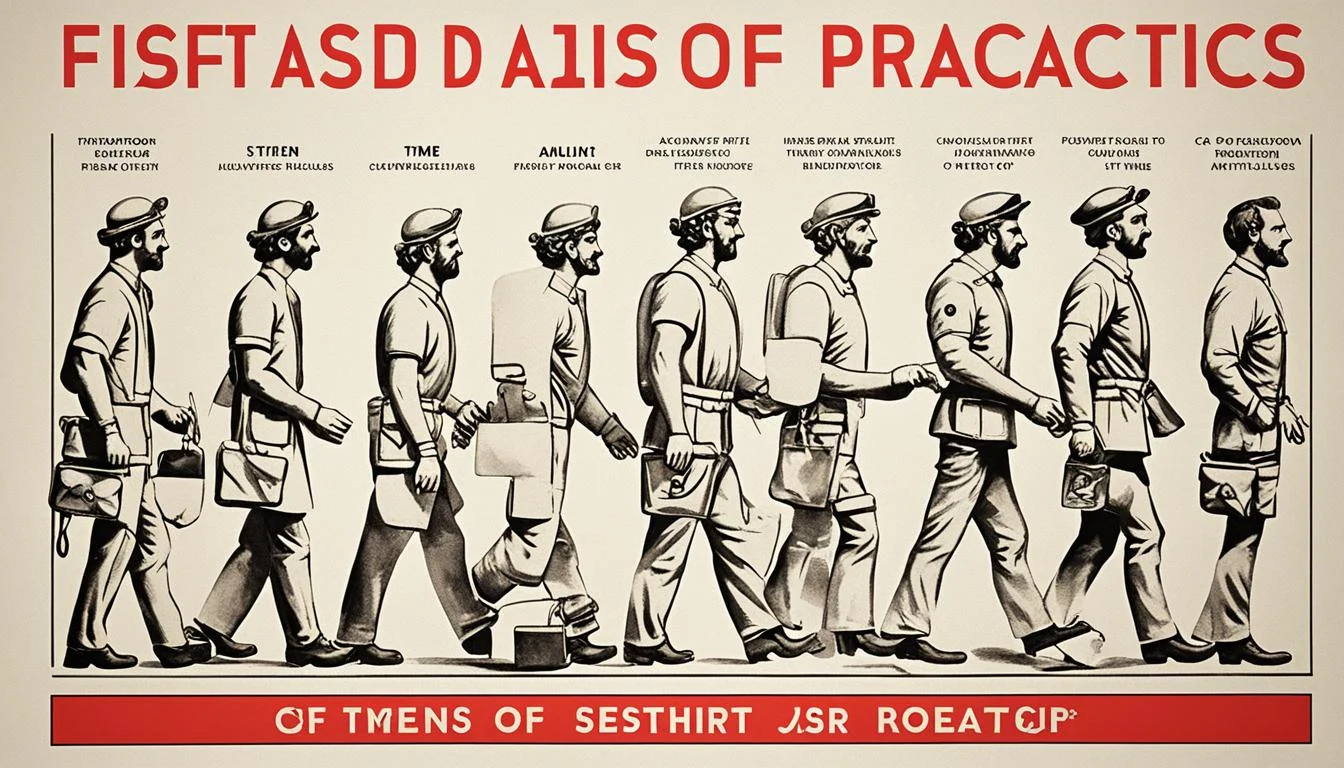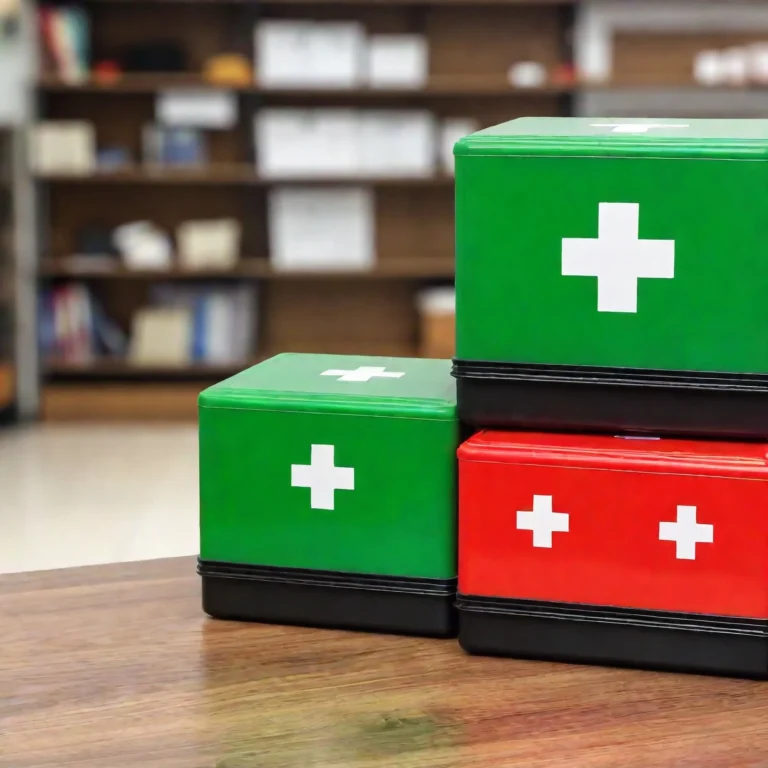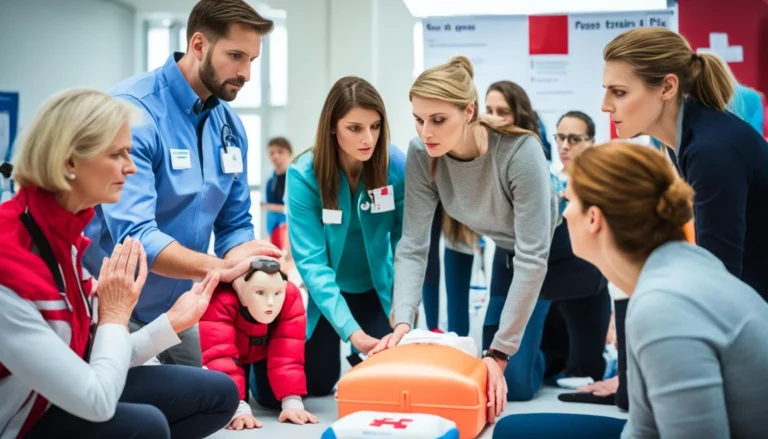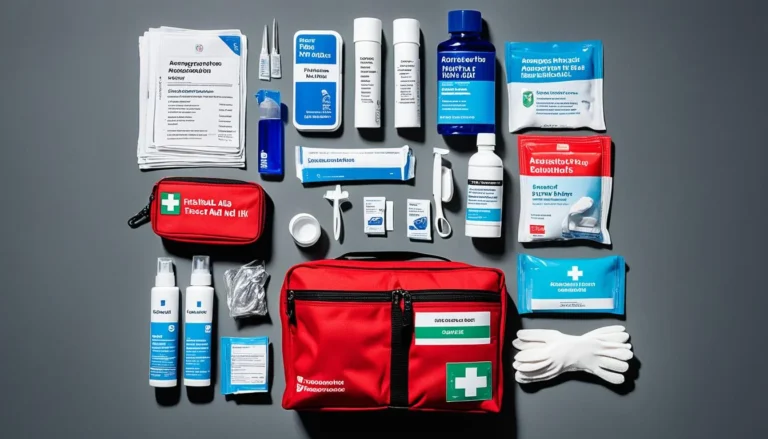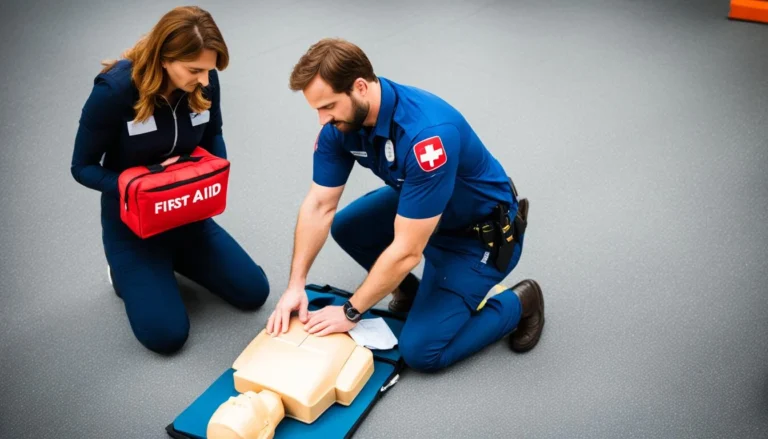When Was First Aid Invented: The Origins
The story of first aid revolves around key moments in how we respond to medical emergencies. In 1882, “First Aid to the Injured” was translated into English by Princess Christian. This marked a big step in the UK’s approach to emergency care.
Soon after, organizations like St. John Ambulance and St. Andrew’s First Aid were set up. They showed a strong commitment to making sure everyone had access to medical help, in war and peace. People such as Friedrich von Esmarch were important in the military field. He highlighted the need to protect wounds when moving patients. His work is a foundation of how we help people in emergencies today.
Key Takeaways
- “First Aid to the Injured” was translated into English by Princess Christian in 1882.
- The formation of St. John Ambulance and St. Andrew’s First Aid marked crucial steps in the UK’s civilian medical care.
- Friedrich von Esmarch’s contributions were pivotal in advancing military first aid techniques.
- Early emergency care principles focused on safeguarding wounds during transportation.
- These early efforts laid the foundation for contemporary emergency medicine.
Early History of First Aid: Ancient Practices
The start of first aid goes way back to ancient times. People then used simple but effective methods to help heal injuries. This laid the foundation for more organised emergency care. It shows how smart and creative our early relatives were.
First Aid During Ancient Civilisations
In ancient Greece and Rome, they showed first aid on their pottery. For instance, Greek pottery from 500 BC showed scenes of wrapping wounds. This shows the use of historical medical practices to stop infections and help wounds heal.
The Good Samaritan Parable
The story of the Good Samaritan marks a big step in medical ethics. It teaches about the core of emergency care. It also talks about compassion and helping those in need. This story focuses on empathy, which was key in ancient first aid techniques.
Role of Roman Capsarii
In the Roman Empire, they had a group called capsarii in their armies. Capsarii were there to quickly help soldiers hurt in battles. They used bandages and simple items to take care of wounds. They were like the first medics in wars, showing the lasting value of historical medical practices.
| Period | First Aid Practice | Significance |
|---|---|---|
| 500 BC | Bandaging in Ancient Greece | Early depiction of wound care |
| 1st Century AD | Good Samaritan Parable | Cultural demonstration of emergency care philosophy |
| 100-400 AD | Roman Capsarii | Precursors to modern combat medics |
First Aid in the Middle Ages: The Knights Hospitaller
In the Middle Ages, the Knights Hospitaller made huge strides in helping the sick and injured. These brave knights were known for their skills in battle. But, they were also the first to offer organised healthcare to those in need. Their methods were advanced for their time, making them pioneers in the field of first aid.
Knights Hospitaller: Pioneers in First Aid
The Knights Hospitaller’s approach to medical aid was new and exciting. They ran hospitals in many parts of Europe, looking after anyone who came, be they travellers or other knights. The care they provided was exceptional, with clean hospitals and staff who knew what they were doing. These practices showed a great deal of knowledge about keeping people healthy.
Impact on Pilgrims and Knights
The work of the Knights Hospitaller went beyond the battlefield. Their ways of treating the sick and injured were life-changing. Travellers on dangerous journeys knew they could find help at Hospitaller hospitals. Likewise, knights hurt in battles could trust in their expertise. This cemented the order’s importance in medieval times, shaping the future of healthcare.
Formalisation in the 18th Century
In the 18th century, a new focus on saving lives started to grow. This was especially true for preventing drowning. Organised groups aimed to rescue people from water, setting the stage for future efforts.
Society for the Preservation of Life from Accidents in Water
In 1767, the Society for the Preservation of Life from Accidents in Water began in Amsterdam. It was one of the first groups dedicated to systematic drowning prevention. They taught methods to save people from accidents in water, shaping how *18th-century lifesaving* was done.
They showed that quick rescue and first aid were key. Their ideas spread worldwide, starting similar groups everywhere.
Role of Royal Humane Society
The Royal Humane Society started in 1774, taking things even further. This UK charity played a big part in introducing artificial respiration. They set a high standard for saving people who nearly drowned.
They worked hard to improve rescue skills and made sure people knew how to help in emergencies. Their work has not been forgotten. The methods they started with in the 18th century are still used today, with a few updates.
When Was First Aid Invented for the Military?
Military first aid began with a big step forward in battlefield medicine. Friedrich von Esmarch, a famous German surgeon, played a vital role. Thanks to his work, the way wounded soldiers were treated improved greatly.
Friedrich von Esmarch: The Pioneer
In the Franco-Prussian War, Friedrich von Esmarch made a difference in military first aid. He stressed the need for swift and effective care for soldiers hurt in battle. His work set a new bar for emergency care during fights, saving many lives.
The Introduction of the Esmarch Bandage
The Esmarch bandage was a game-changer in battlefield medicine. It helped stop bleeding and secure wounds. This was a lifesaving tool. Esmarch included it in his first aid teachings, calling them “erste hilfe,” or “first help.” This approach was a major step forward.
| Aspect | Before Esmarch | After Esmarch |
|---|---|---|
| First Aid Training | Informal and inconsistent | Formalised and standardised |
| Equipment Used | Basic and varied | Standardised equipment like the Esmarch bandage |
| Care Protocols | Variable across different units | Uniform guidelines for battlefield care |
Esmarch’s work became the basis of today’s battlefield emergency care. He made sure care was given more uniformly and effectively. This showed how critical good organisation and preparation are in life-saving situations.
Evolution of First Aid During the 19th Century
The 19th century was a big time for first aid. It saw big changes through the work of some very important people. They laid down the basics for helping in emergencies and how to organise to do it better.
Jean-Henri Dunant and the Red Cross
Something very important happened in 1859 during the Battle of Solferino. Jean-Henri Dunant saw lots of soldiers badly hurt. This made him believe in helping out without taking sides and he set the stage for the Red Cross foundation in 1863.
This Red Cross foundation started a worldwide movement. It aimed to help wherever there was war, showing the world how to act fast and fairly in emergencies.
Influence of Surgeon-Major Peter Shepherd
Now, let’s talk about British Surgeon-Major Peter Shepherd. He pushed to make first aid not just for wars, but for everyone. He loved teaching medical care to regular people, and so he led many first aid lessons.
By spreading first aid to the public, Peter Shepherd’s work was key in how modern first aid spread. His focus on teaching made a big difference, helping many people in the British Empire learn how to help in small or bigger ways.
The work of these people is very important. They shaped the first aid we know today. Their teachings and efforts are still seen in how we help each other in emergencies.
The Rise of Civilian First Aid in the United Kingdom
In the late 19th century, organised civilian first aid started in the UK. This was a key moment in the *St John Ambulance history* and the growth of *civilian medical response training*. It led to wide-spread first aid lessons and health promotion for everyone.
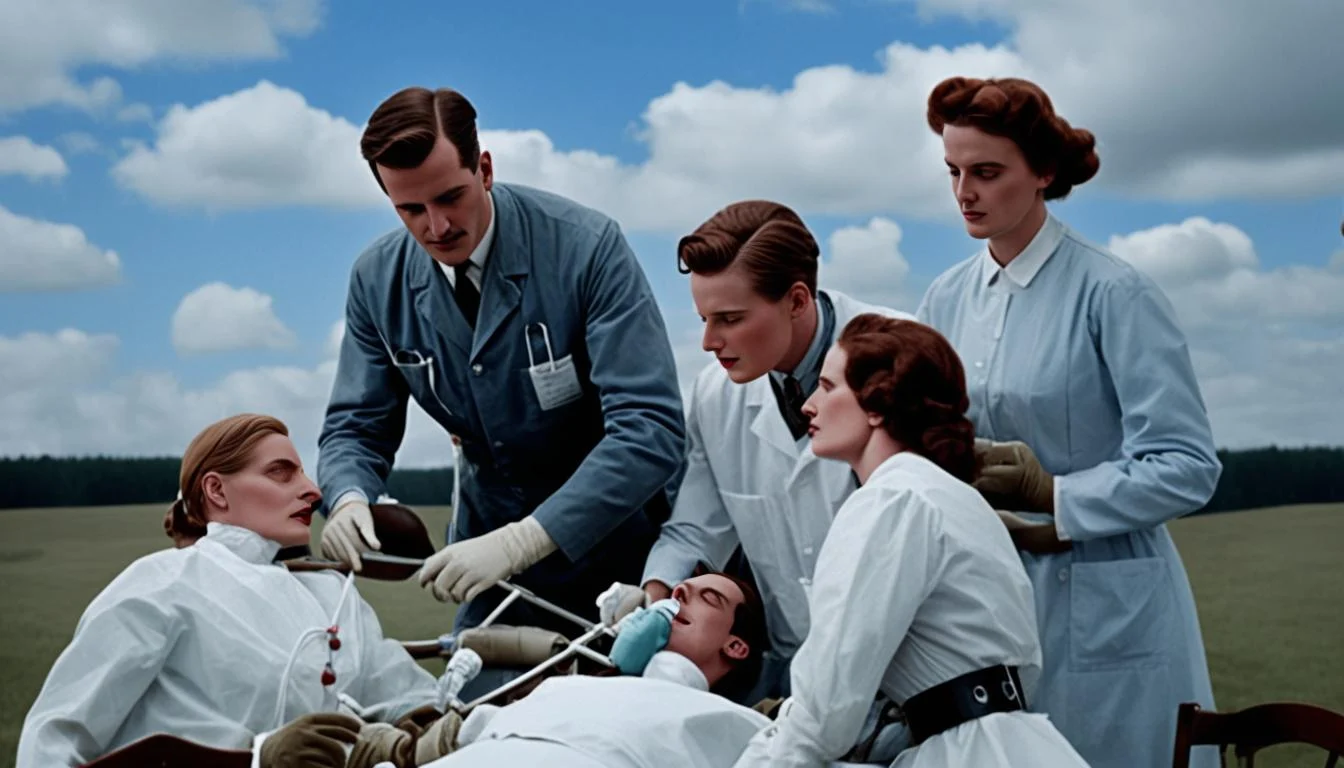
St John Ambulance Association
The St John Ambulance Association was a major player in this change. It was set up in 1877 to give first aid lessons and teach about health and safety. The founders knew it was vital for ordinary people to learn how to help in a crisis.
St Andrew’s First Aid Initiative in Scotland
Scotland saw the rise of *St Andrew’s First Aid* in 1882, adding to the work of St John Ambulance. It focused on teaching first aid that fit Scotland’s needs. Their work in *civilian medical response training* boosted health and safety in Scotland.
These groups show a big change in *St John Ambulance history* and first aid culture. They pushed for the whole country to learn about health and be ready for emergencies. This set the base for how the UK does first aid today.
Development of First Aid Training Programmes
First aid training started with Dr. Friedrich von Esmarch’s work. His new methods were a big step in teaching people how to help medically. This began the path for proper first aid education in both military and everyday life.
Implementations by Dr. Friedrich von Esmarch
Dr. Esmarch changed the game by showing soldiers and nurses how to handle medical situations. He created the “Esmarch bandage” to make learning easier. This bandage showed that good medical practices help everyone, not just soldiers. His work improved care in battles and hospitals.
The Role of St John and St Andrew Organisations
Places like St John Ambulance and St Andrew’s First Aid built on Esmarch’s ideas. They made sure everyone could learn first aid. These groups started programmes to teach regular people how to respond in emergencies. Their work is key in spreading first aid skills across the globe.
Modernisation of First Aid: 20th Century Innovations
The 20th century brought big changes in first aid, mixing old ways with new modern methods. It saw the birth of many first aid tools and taught people how to use them. This time is special for setting the stage for first aid as we know it today.

In the 1960s, cardiopulmonary resuscitation (CPR) became a key first aid skill, saving many lives. Then, Automated External Defibrillators (AEDs) came about, showing just how far technology can help us save lives. You can now find AEDs in many public places, ready for anyone to use in an emergency.
- Introduction of CPR: A life-saving first aid technique developed in the 1960s.
- Automated External Defibrillators (AEDs): Technological tools designed for rapid response to cardiac emergencies.
- Improved pre-hospital care: Enhanced medical kits and equipment ensured more effective on-the-spot treatment.
First aid training also became more thorough in the 20th century. It grew to include new skills like how to help someone who’s been through a lot. The Red Cross and St John Ambulance played a big part in this. They made sure everyone could learn first aid, no matter who they are.
| Period | Innovation | Impact |
|---|---|---|
| 1960s | CPR | Revolutionised emergency response, saving countless lives. |
| Late 20th century | AEDs | Widespread accessibility, crucial for treating cardiac arrest. |
| 20th – 21st century | Psychological First Aid | Provides mental health support during emergencies. |
Overall, the 20th century changed how we think about first aid. It showed us the power of new technologies and the importance of being ready to help. This laid the foundation for the first aid we teach and use today, making our world safer.
The Importance of First Aid Training Today
First aid training is key to keeping us safe and healthy today. It teaches life-saving skills for immediate help during emergencies. This not only helps with physical injuries but also supports mental and emotional well-being. It offers a full approach to care during tough times.
First aid courses now cover more than just basic skills. They include how to support someone emotionally after a tough event. This extra support makes our response to emergencies more complete. These skills are golden in many places like work, school, and home, boosting community readiness.
First aid education is always getting better. It makes sure training keeps up with new medical info and technologies. This way, first responders of any kind are ready for anything. Learning these life-saving skills makes us all safer and more helpful in society.

